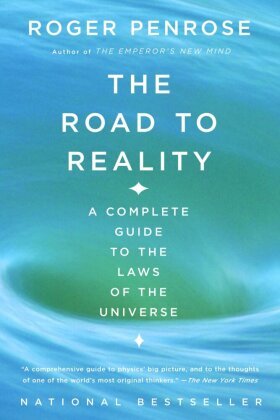The Road to Reality - A Complete Guide to the Laws of the Universe
| Verlag | Vintage |
| Auflage | 2007 |
| Seiten | 1136 |
| Format | 15,4 x 23,4 x 5,3 cm |
| Gewicht | 1148 g |
| Artikeltyp | Englisches Buch |
| Reihe | Vintage |
| ISBN-10 | 0679776311 |
| EAN | 9780679776314 |
| Bestell-Nr | 67977631EA |
Nobel Prize-winner Roger Penrose, one of the most accomplished scientists of our time, presents the only comprehensive and comprehensible account of the physics of the universe.
A "guide to physics big picture, and to the thoughts of one of the world s most original thinkers. The New York Times
From the very first attempts by the Greeks to grapple with the complexities of our known world to the latest application of infinity in physics, The Road to Reality carefully explores the movement of the smallest atomic particles and reaches into the vastness of intergalactic space.
Here, Penrose examines the mathematical foundations of the physical universe, exposing the underlying beauty of physics and giving us one the most important works in modern science writing.
Inhaltsverzeichnis:
Preface
Acknowledgements
Notation
Prologue
1 The roots of science
1.1 The quest for the forces that shape the world
1.2 Mathematical truth
1.3 Is Plato s mathematical world real ?
1.4 Three worlds and three deep mysteries
1.5 The Good, the True, and the Beautiful
2 An ancient theorem and a modern question
2.1 The Pythagorean theorem
2.2 Euclid s postulates
2.3 Similar-areas proof of the Pythagorean theorem
2.4 Hyperbolic geometry: conformal picture
2.5 Other representations of hyperbolic geometry
2.6 Historical aspects of hyperbolic geometry
2.7 Relation to physical space
3 Kinds of number in the physical world
3.1 A Pythagorean catastrophe?
3.2 The real-number system
3.3 Real numbers in the physical world
3.4 Do natural numbers need the physical world?
3.5 Discrete numbers in the physical world
4 Magical complex numbers
4.1 The magic number i
4.2 Solving equa tions with complex numbers
4.3 Convergence of power series
4.4 Caspar Wessel s complex plane
4.5 How to construct the Mandelbrot set
5 Geometry of logarithms, powers, and roots
5.1 Geometry of complex algebra
5.2 The idea of the complex logarithm
5.3 Multiple valuedness, natural logarithms
5.4 Complex powers
5.5 Some relations to modern particle physics
6 Real-number calculus
6.1 What makes an honest function?
6.2 Slopes of functions
6.3 Higher derivatives; C1-smooth functions
6.4 The Eulerian notion of a function?
6.5 The rules of differentiation
6.6 Integration
7 Complex-number calculus
7.1 Complex smoothness; holomorphic functions
7.2 Contour integration
7.3 Power series from complex smoothness
7.4 Analytic continuation
8 Riemann surfaces and complex mappings
8.1 The idea of a Riemann surface
8.2 Conformal mappings
8.3 The Riemann sphere
8.4 The genus of a compa ct Riemann surface
8.5 The Riemann mapping theorem
9 Fourier decomposition and hyperfunctions
9.1 Fourier series
9.2 Functions on a circle
9.3 Frequency splitting on the Riemann sphere
9.4 The Fourier transform
9.5 Frequency splitting from the Fourier transform
9.6 What kind of function is appropriate?
9.7 Hyperfunctions
10 Surfaces
10.1 Complex dimensions and real dimensions
10.2 Smoothness, partial derivatives
10.3 Vector Fields and 1-forms
10.4 Components, scalar products
10.5 The Cauchy Riemann equations
11 Hypercomplex numbers
11.1 The algebra of quaternions
11.2 The physical role of quaternions?
11.3 Geometry of quaternions
11.4 How to compose rotations
11.5 Clifford algebras
11.6 Grassmann algebras
12 Manifolds of n dimensions
12.1 Why study higher-dimensional manifolds?
12.2 Manifolds and coordinate patches
12.3 Scalars, vectors, and covectors
12.4 Grassmann products
12.5 Integrals of forms
12.6 Exterior derivative
12.7 Volume element; summation convention
12.8 Tensors; abstract-index and diagrammatic notation
12.9 Complex manifolds
13 Symmetry groups
13.1 Groups of transformations
13.2 Subgroups and simple groups
13.3 Linear transformations and matrices
13.4 Determinants and traces
13.5 Eigenvalues and eigenvectors
13.6 Representation theory and Lie algebras
13.7 Tensor representation spaces; reducibility
13.8 Orthogonal groups
13.9 Unitary groups
13.10 Symplectic groups
14 Calculus on manifolds
14.1 Differentiation on a manifold?
14.2 Parallel transport
14.3 Covariant derivative
14.4 Curvature and torsion
14.5 Geodesics, parallelograms, and curvature
14.6 Lie derivative
14.7 What a metric can

